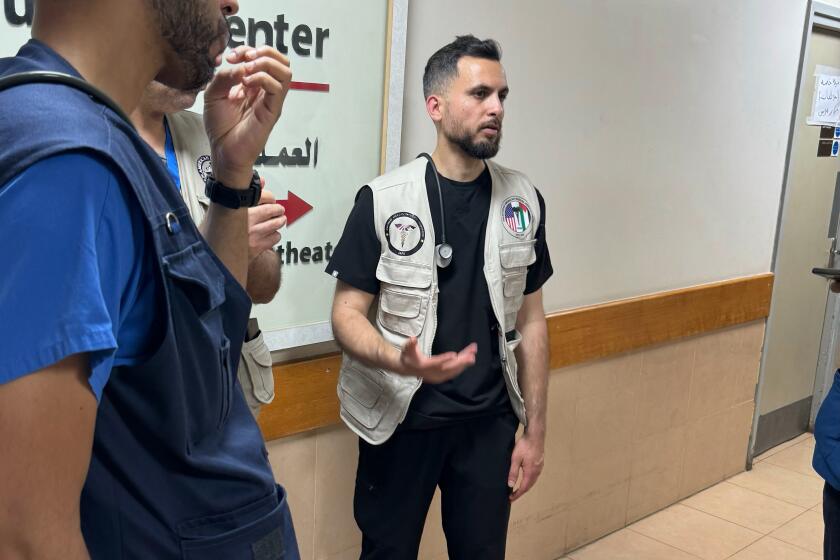Detecting Hazards No Technological Slam-Dunk
As law enforcement agencies around the nation scramble to purchase devices that can detect biological hazards such as anthrax, experts in the field offer this warning: Buyer, beware.
Although many firms are selling devices to sniff out pathogens in the air and the soil, the technology still is in an early stage of development. Most devices now on the market can detect just a few of the more than two dozen biological agents that could plausibly be harnessed as weapons of war or terrorism. Much of the equipment that does exist is cumbersome and expensive.
And the most popular method for speedy, on-the-spot detection--strips that resemble home pregnancy tests--can be tricked into giving false negatives if the pathogen is masked with common household chemicals before it’s mailed to victims in envelopes or sprayed over a city.
In a draft report on detection devices released this month, the Justice Department concluded that most such gadgets “exhibit limited utility” and urged prospective buyers to “be very careful when considering a purchase of any device that claims to detect [biological] agents.”
The Los Angeles County Fire Department has heeded that warning. Put off by the high cost and the questionable accuracy of commercially available equipment, the department has not purchased a single such device.
“We are very short on that,” Battalion Chief Ron Watson said.
Indeed, with no equipment of its own, the county hazardous materials team has to send all suspicious biosubstances to the FBI or medical laboratories for testing--a process that, in the case of anthrax, can take days. Officials now are scouring catalogs and comparing notes with other emergency response teams to find a detection device that would be affordable and reliable. So far, Watson said, “we have not found a match.”
Development of good biodetection equipment has been slow for several reasons.
First, and most basic, is the scientific challenge. The devices are tough to design. As one federal expert put it: “We’re living in a soup with biological bits floating around us at all times. How do you sort out the good bits from the bad bits?”
The answer most engineers have come up with is to scan for one particular “bad bit” at a time. Which means that a device engineered to detect anthrax cannot detect any other pathogen, even in massive quantities. And scientists have been slow to develop tests for every possible germ agent because, until now, the threat has not seemed serious enough to justify the expense of all that research.
“Obviously, technology always chases money. And I think within the next couple of months, we’re going to get a whole heck of a lot smarter at this,” said Martin Masiuk, who runs an online clearinghouse for emergency response crews and equipment vendors.
The technology in use today employs three basic approaches:
The gold standard is to grow suspicious bacteria in a lab for hours or days. As the bacteria multiply, scientists test for deadly germs by staining the colonies (anthrax, for instance, adheres to a certain type of stain) or by feeding them various combinations of nutrients (different pathogens thrive on different diets). The accuracy of such tests is excellent, but results can take days.
A quicker method--which still takes at least half an hour--is to extract DNA from the suspicious organism, multiply it and then compare it against the genetic code of known pathogens. The trick is developing a database of deadly germ DNA and figuring out how to identify matches without scanning the entire length of genetic code. It also helps greatly to have clean samples of the suspect bacteria.
Nanogen Inc., a San Diego firm, has a three-year grant from the Army to develop a portable kit using this technology. So far, the firm has figured out how to test a suspicious sample to see if it matches any one of six pathogens.
“That’s obviously not enough,” CEO Randy White said with a sigh. Nor is the device compact enough to be portable.
The biological detection kits that are the most portable rely on a third technology. Each test stick contains antibodies known to bind to the proteins of a specific germ. If the germ is present, the antibodies will bond to it, and the test stick will signal a hit.
Such kits are popular because they’re quick, offering results in 15 minutes or less. They’re also relatively inexpensive: Tetracore, a Maryland company, sells a box of 25 anthrax test strips for $495.
Yet they, too, have limitations. Tetracore markets strips that can test for anthrax, ricin, botulinus and a staphylococcal bacteria. But there are no kits to probe for Venezuelan equine encephalitis or bubonic plague or Marsburg virus, all pathogens that the Justice Department considers highly likely to be used as biological weapons.
And while Tetracore promises 95% accuracy, experts say the tests can be “spoofed” into giving false negatives if the deadly germ is mixed in with certain household chemicals. Another concern: The test is not ultra-sensitive. It’s possible that there could be enough of a given pathogen to cause disease, but not enough to trigger a hit on the test strip.
“There’s not a doubt in my mind” that the tests will sometimes give false reassurance, said Chief John Eversole, chairman of the hazardous materials committee for the International Fire Chiefs Assn. “But there is no perfect world here. That’s the most practical device out on the market today.”
Eversole is certain, however, that technology will improve--and quickly.
“Biowarfare is obviously something that’s relatively new to us. Now that we know there are people strange enough to be willing to use these things on other human beings, we will get really good at detecting them.”
More to Read
Start your day right
Sign up for Essential California for news, features and recommendations from the L.A. Times and beyond in your inbox six days a week.
You may occasionally receive promotional content from the Los Angeles Times.






